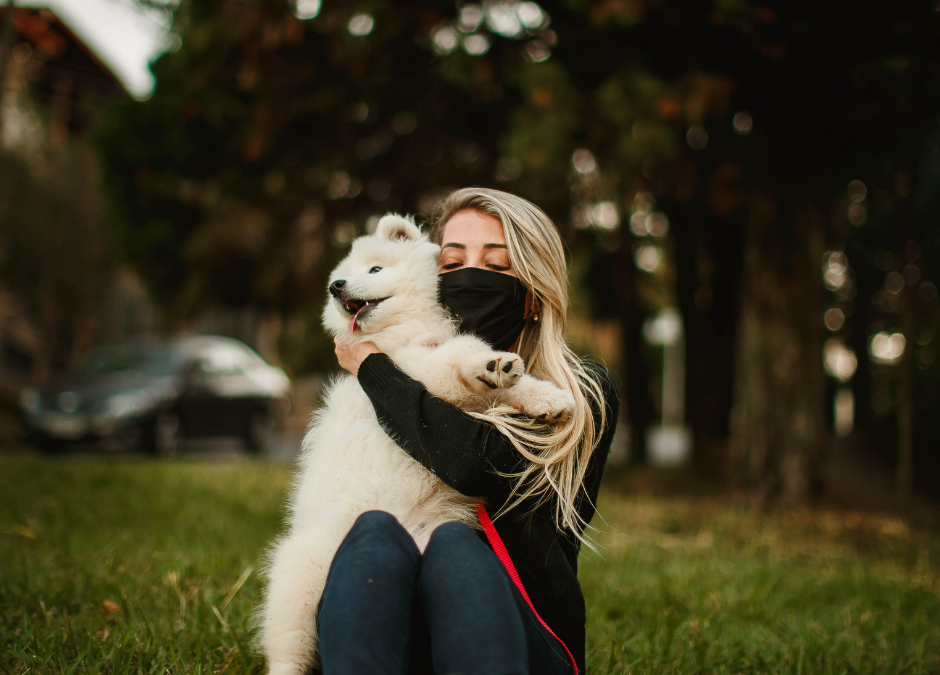Did you add a new dog to the family during the pandemic? Learn how to to peacefully cohabitate with your Pandemic Puppy.
During this “year on pause” did a family dog suddenly seem like a great idea?
Your vision likely includes:
- lounging on the couch together watching TV
- walking twice a day to keep off the pandemic pounds
- cuddling up at night in the same bed
You’re not alone.
Shelters, rescues, breeders, pet stores — all reporte more demand than there were dogs and puppies to fill it.
Well…
A year later maybe that pandemic puppy causes you some heartache as they try to integrate into a new home.
And, it’s not just puppies. Family dogs of all ages have become used to their human family being around more, and going back to work could cause separation anxiety.
Here are some things you can do to cohabitate with the family dog more peacefully;
Daily Walks Are Key
The daily walk routine is a fundamental part of your family dog’s happiness. Experiencing different smell, sights and sounds stimulates their brain. I once heard it referred to as “reading the newspaper.” It helps create confidence with unfamiliar places, people and sounds. The exercise is good for them too – and for you.
Teach Basic Commands – Consistently
Spend about 15 minutes each day teaching them the basics – sit, stay, down, come, off, heel, and no. Make training feel like a game to your pup. That looks like treat time with you – two things your family dog loves. For a young puppy, training can also burn off excess energy because it takes focus to learn new skills.
Must You Crate Train Your New Dog?
A family dog’s crate is their safe spot. You want them to be able to go to this spot any time they are anxious, uncomfortable, or overwhelmed by what’s going on in the house (vacuum cleaner and rowdy kids included). You also want them to go there on command when need them to be contained. You might also choose to have them stay in their crate anytime you are actually away from home or to sleep there overnight, and you want them to go there willingly and easily.
Leave That New Dog Alone (Gasp!)
Introduce “alone time” to your new dog as early as possible. It’s difficult to pay attention to a Zoom meeting with a puppy trying to climb in your lap or begging you for a treat or bringing you the squeaking chicken toy.
To reduce separate anxiety or isolation anxiety, work up to leaving your dog in a separate room a few minutes at a time and stretching that duration out over several days.
Your family dog needs to feel comfortable on their own, even if you are home more often.
A Pro Can Help Your New Dog
You can do a lot on your own from home, but each dog has a unique personality and potential challenges that could benefit from lessons with a professional dog trainer.
There are options for on-demand virtual dog training or socially distant safe dog classes that will help you communicate and connect with your dog. Remember, every family has its own set of rules. Your new dog needs to learn what being a “good canine citizen” is in your house. A professional trainer helps you establish which behaviors need improvement and which might be the result of a misunderstanding.
For you, it’ requires a little time, effort, energy, and patience. Taking the time to help your pandemic puppy become a well-mannered family dog creates long-term happiness. Just 15 minutes a day of reinforcement training each day also builds a stronger bond between you both.
Fresh Air is Fundamental
Getting outside, especially since we’ve all been stuck at home, is important to your dog’s training. It introduces them to all kinds of new things in their world – people, smells, sights, and sounds. Getting your dog comfortable with different environments help them feel more confident and less fearful, leading to overall better behavior. So, get out and get some fresh air with your dog.
Is your dog used to you being home ALL. THE. TIME? We are seeing an increase in separation anxiety and isolation anxiety in dogs who are not used to being alone. We recommend your dog gets comfortable with you not around – even if you’re only in the next room, or if you actually leave the house.
If you notice your dog whining when you’re not around, get some help training your dog to be alone before it becomes a behavior problem.

